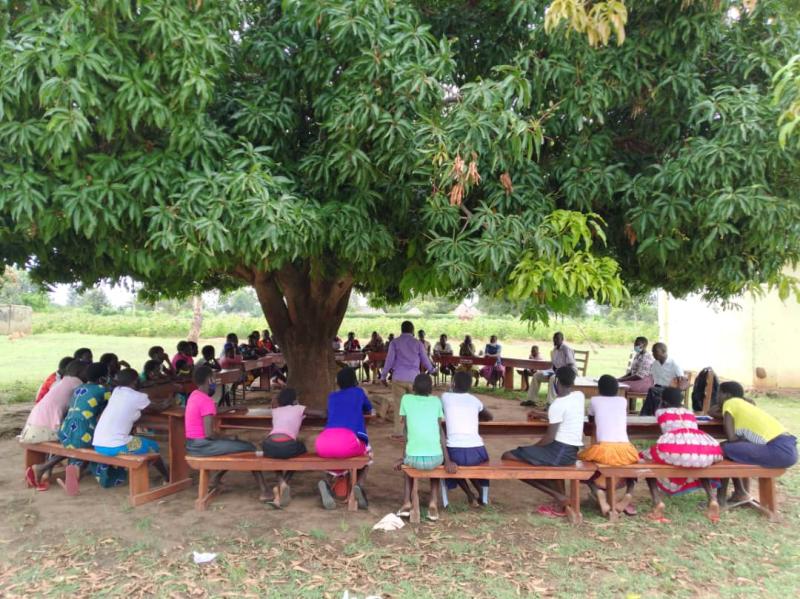Where We Work
See our interactive map


A community youth dialogue on teenage pregnancies with young women in the Ngora District of Uganda.
6 ways this team provides crucial health care to women and girls during a global pandemic.
In 2020 alone, 1 in 10 girls between the ages of 15 and 19 became mothers and 1 in 5 got married or entered into a civil union. In Uganda, COVID-19 related restrictions such as lockdowns and school closures led to pregnancies for over 90,000 girls under 18.
These statistics demonstrate how critical it is to help women of reproductive age make informed decisions regarding sexual relationships, contraceptive use, and reproductive health.To do this, family planning services are key. IntraHealth International, through the USAID-funded Regional Health Integration to Enhance Services in Eastern Uganda (RHITES-E) project, works with the Uganda Ministry of Health to implement a comprehensive program in the eastern Uganda and Karamoja regions that offers clients services in family planning, HIV, and maternal, neonatal, and child health.
Here are six approaches the project uses during COVID-19 lockdowns to improve services for young women and girls:RHITES-E hosted 1,000+ young men and 1,400+ women in groups across five districts to talk about teenage pregnancy.
Our team identified and trained youth champions who now promote the use of a Ministry of Health toll-free line and the Uganda Child Helpline for online counseling services for adolescents and youth. And a new WhatsApp group promotes sexual and reproductive health discussions by creating a safe space for young people to share experiences and ideas about teenage pregnancies and sexual and other forms of gender-based violence.
RHITES-E used the Stepping Stones model, which helps young people stay safe, engage in income-generating activities, remain HIV-negative, be assertive to prevent violence, and make use of available health services to empower and mobilize girls and young women from the Tororo, Butaleja, Mbale, and Amuria districts.
This model helped them access health services for family planning, sexually transmitted infections screening and treatment, antenatal care, HIV testing, and pre-exposure prophylaxis for HIV. As a result, 2,760 women received family planning services. Clients were also screened for gender-based violence and 287 cases were identified and managed.
During COVID-19, there was no transport to and from the health center because of the restrictions.
“During COVID-19, there was no transport to and from the health center because of the restrictions,” says Tabitha Akwi, a 24-year-old mother of three. “I opted to walk to the health center for my family planning method. It is safe, convenient, and offers long-term protection against pregnancy especially now during the pandemic.”
COVID-19 has disrupted the contraceptive supply chain. Limited production, distribution, and availability of contraceptives means that stockouts are common.
“I use injectables every three months but during the pandemic I found it difficult to access my injectables because of the restrictions,” says 24-year-old Juliet Antodi. “I had to go to a further health facility for my injectable, which was costly.”
So RHITES-E tracked all available medical products monthly and helped 25 districts redistribute their available supplies and order additional products. The project also mobilized and delivered 362 essential family planning supplies—such as speculums, tenacula, and sponge-holding forceps—to 26 health facilities.
During COVID-19, RHITES-E partnered with four civil society organizations—the Mbale Area Federation of Communities, Goshen Blessings, Uganda Moslem Rural Development Association, and Uganda Development Health Association—to generate demand for sexual and reproductive health services.
The local organizations conducted youth-focused community dialogue meetings (by gender and age), home visits, and community sensitization meetings in eight local districts. These included family planning and HIV health education, dispelling myths and misconceptions, and emphasizing the importance of HIV testing. They also provided referrals for services at the nearest health facilities or outreach clinics if needed.
I wish I had had information about family planning like I do now.
RHITES-E worked with cultural and religious leaders to help them talk to youth about sexual and reproductive health services. During RHITES-E’s community drives and radio talk shows, cultural and traditional leaders addressed myths, misconceptions, and harmful social norms and practices like early marriage.
They worked with “duty bearers” such as police and other local leaders to help transform gender norms and eliminate socio-cultural biases. This coordination led many young people to change their behaviors, including around condom use.
“I stopped going to school due to the COVID-19 lockdown and I got pregnant thereafter,” says Catherine Airo, a 19-year-old from Olela Village in the Amuria District. “I felt bad. I wish I had had information about family planning like I do now.”
The sexual and reproductive health needs of young women and girls in low- and middle-income settings require special attention, especially during major global health threats like COVID-19. A multi-sectoral approach that helps educate clients and improve access to these services and ensures that supply can meet demand is critical.
Client-centered approaches like these can bring services to the community and help more women and girls get the services they need—even during a pandemic.
Get the latest updates from the blog and eNews




